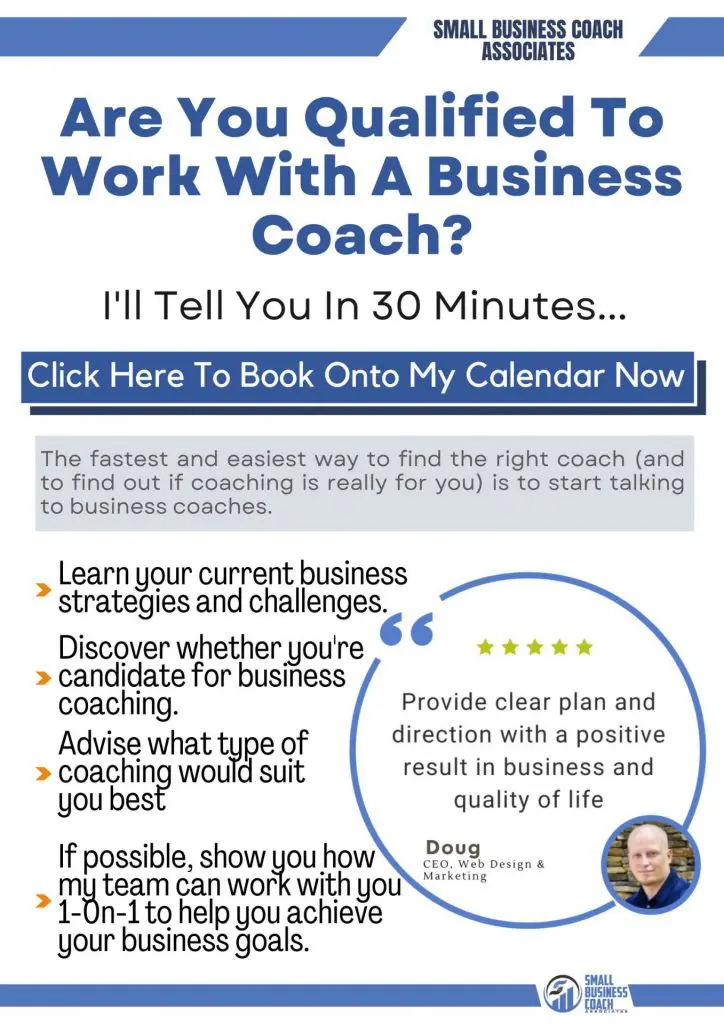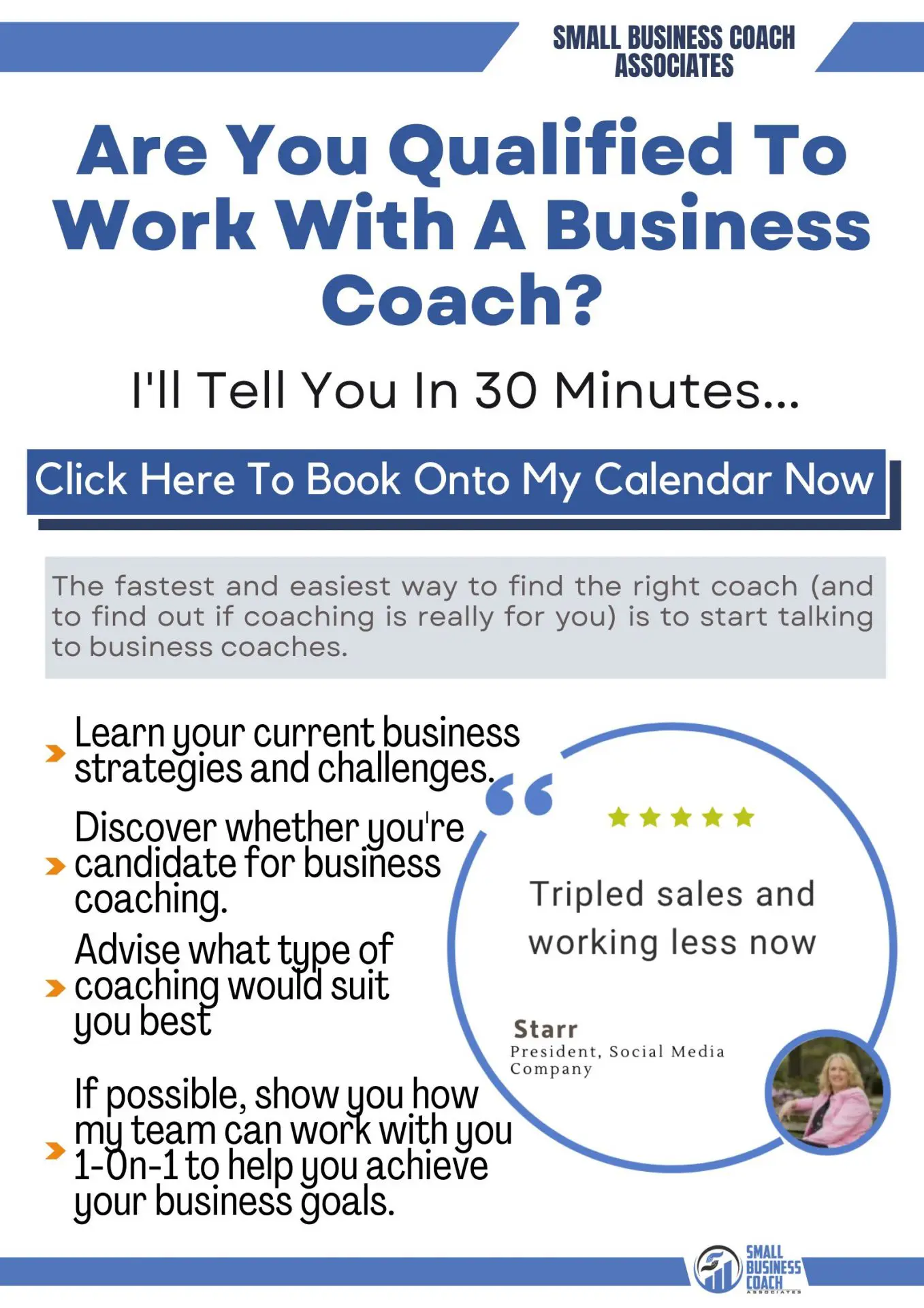The 45 Best Business Coaches to Follow in 2023
Bonus Material: Expanded List Of 90 Best Business Coaches.
Today I’m going to introduce you to 45 highly skilled business coaches, any of which is qualified to help you move the needle in 2023.
Grab my full list of 90 top business coaches with tips for choosing the best coach below:
In this blog post, you can find the best business coaches for everything you need in your business that meets your specific business goals.
With a business coach, you stand to gain a greater self-awareness mindset and increase productivity, performance, and confidence. These business coaches have the necessary skills and experience to meet your business needs and help you achieve your goals.
With the help of a business coach, you can gain heightened self-awareness, improved productivity, better performance, and unshakeable confidence in yourself and your business.
Each business coach has unique skill sets and experiences, which make them ideal for helping you meet your objectives. No matter what type of business you have, there is sure to be a coach who can help take your business to the next level.
If you need to take your business to the next level and make a difference among other businesses, here is the list of 45 of the best business coaches you can follow:
1. Alan Melton, Entrepreneur, Small Business Expert and Small Business Coach
Alan Melton is known for getting results for his clients and his businesses. The award-winning process of Small Business Coach Associates, “The 7 Stages To Business Freedom,” along with its talented coaches, has consistently produced exceptional results for over 1,100 business owners, increasing their sales by more than $337million. One client was recently featured in Forbes Magazine; another was recently named a fastest growing company by Inc 5000. Their clients have increased their sales and profits with less stress. They are doing what they love in their business. They are enjoying their lifestyle, hobbies, and spending time with their families.
Alan is a well-known author, speaker, and business leader with an international reputation. He has founded twelve companies and bought five additional ones. Currently, he is coaching, mentoring, and consulting a group of talented entrepreneurs and executives who are on the fast track to success. He also received awards including the Inc 500 fastest growing companies, SBA’s Small Business Person of the Year, and the Sterling Award for Organizational Performance Excellence.
Small Business Coach Associates, founded by Alan, has been recognized by various organizations, including Hubspot, Influence Digest, Protoly, Deliberate Directions, Feedpost, Fast Upfront, and Six Figure Coach Magazine as one of the top business coaching organizations worldwide.
Pro-Tip: Grab 30 minutes on my calendar to ask any questions you have about business coaching. I’ve been a business coach (and business broker) for over 20 years. I also have a business coach of my own, so I know what successful coaching looks like on both sides of the table.
~ Alan Melton, Small Business Coach Associates

2. Erin Henry, Australian Motivator and Digital Entrepreneur
In 2018, Erin established the Game Changer Company to expand the reach of her courses and coaching to more students.
She is an Australian motivator and digital entrepreneur with millions of followers on YouTube and other social media platforms. Through her company, she helps thousands of beginning entrepreneurs how to grow their businesses.
As a business coach, she is working on improving the next generation of leaders to rise and take over the business world.

3. Karl Bryan, Coaching Sales and Marketing Expert
Karl Bryan is the CEO of one of the world’s fast-growing E-learning companies for business coaches. This company publishes E-learning marketing systems for small businesses. According to top marketing experts, this is the most attractive business coaching program ever developed for clients.
He is also the founder and editor-in-chief of Six-Figure Coach Magazine. He and his business partner, Adrian Ulsh, provide weekly training to business coaches in the area of marketing.

4. Barry Moltz, Entrepreneur, Author, Motivational Speaker, and Small Businesses
Barry is a business expert helping small businesses to reach their maximum potential. He has many years of entrepreneurial experience, from managing his own business and serving as a business coach to many other entrepreneurs.
He is also a well-known author. His first book, titled: Need to be a Little Crazy: The Truth About Starting and Growing Your Own Business, has been translated into four other languages. Presently, he has written six other books aimed at helping small businesses to be more profitable. Today, he is a recognized speaker and has had the opportunity to speak in countless business shows.
Pro-Tip: Grab 30 minutes on my calendar to ask any questions you have about business coaching. I’ve been a business coach (and business broker) for over 20 years. I also have a business coach of my own, so I know what successful coaching looks like on both sides of the table.
~ Alan Melton, Small Business Coach Associates

5. Melinda Emerson, Small Business Expert
With over 20 years of experience, Melinda has utilized her expertise to elevate her own business. She is now internationally recognized as a motivational speaker and a business coach in developing small businesses and social media marketing.
Each week, she offers advice to over three million entrepreneurs worldwide through her blog. Her expertise has gained recognition from prominent organizations including SCORE, Forbes, Inc Magazine, and others.

6. Sheri Kaye Hoff, Business Coaching and Mindset Expert
Sheri Kaye is a business coach who works with business consultants, entrepreneurs, and small business owners. She is recognized as an expert in promoting business growth and motivating her clients to take strategic actions toward expanding their businesses.
Sheri has a broad audience that finds inspiration in her unique business coaching style and techniques, which has led her to write multiple books about achieving success. Throughout her career as a business coach, Sheri has impacted the lives of hundreds of people through her programs.

7. Andy Turner, Sales and Marketing Strategist
Andy has 23 years of corporate experience and world-class marketing and sales skills. He is also the author of two highly acclaimed books that deal with the problems of building a successful business and provide easy strategies on how to earn quick profits and make your business grow. He offers direct business coaching courses for entrepreneurs and business owners who want to expand their businesses.

8. Melissa Dawn, Speaker, Coach, Author of CEO of Your Life and Business
Melissa is a famous speaker and business coach with a certificate from a certified professional Co-Active Coach (CPCC) and others. She is a coach who specializes in both life and business, guiding business owners to create a custom-built business that suits their desired lifestyle and values.
She specialized in helping people grow from their day-to-day jobs to become entrepreneurs in what they are passionate about. Melissa is the author of a book on entrepreneurship, and her company is one of the best HubSpot business coaching services for 2019.

9. Ian Brodie, How to Get More Clients
Ian is working with consultants, business coaches, and other professionals to help them attract and win more clients without the pain and expense of traditional marketing. Get the latest blog posts on how to get more clients for your business consulting or business coaching firm from best-selling author Ian Brodie.
10. Dan Sullivan, Founder and President of the Strategic Coach Inc.
Dan Sullivan is indeed a visionary and gifted theoretical thinker. He has 40 years of experience as a motivational speaker, consultant, strategic planner, and business coach to entrepreneurs and business owners. Dan has written more than 30 publications about business and how to grow in business. Apart from strategic business coaching he presently runs a successful coaching program for entrepreneurs to bring out their potential in life and work.

11. Brad Sugars, Founder and CEO of Action Coach
Brad started as a business coach in his late twenties, and today his business is recognized as one of the world’s leading business coaching firms. With his entrepreneurship skills, Brad started small business and turned them into profitable businesses. Because of his skills and achievements, it earned him the name “the turnaround kid.”
Brad shares his expertise with business owners and entrepreneurs on various topics such as sales, marketing, team-building, and systematization. He has business coaches located around the world.

12. Loren Fogelman, Spokesperson and Business Coach
Loren Fogelman is a spokesperson and one of America’s top-ranked business coaches. She was named one of the top coaches in HubSpot for 2018 and 2019. As a spokesperson, Lauren gives speeches throughout the United States and specializes in sales and pricing strategies, particularly for small businesses.
She offers business coaching services specifically designed for service-based entrepreneurs who wish to increase their revenue quickly. Her coaching primarily focuses on transitioning from a dollar-per-hour business model to a value-based one.

13. Tommi Wolfe, the Startup Expert
Tommi is an expert that helps startup businesses to sell their products or services, find clients, and increase sales. She is a CEO, business leader, and entrepreneur with many accomplishments. With her skills, business experience, and qualifications, she provides business coaching to business owners and entrepreneurs to help them achieve their business goals by making the business profitable, sustainable, and competitive.

14. Robert Viney, Business Coach, and Entrepreneur
Robert Viney is a well-known business coach who is successful in business coaching and entrepreneurship. He founded a renowned business coaching service that offers effective programs to help individuals succeed in their businesses.
His main focus is to share his knowledge and experience with other businesses, helping them to become more intelligent and innovative in their approach to generating greater profits while minimizing stress and effort.
Pro-Tip: Grab 30 minutes on my calendar to ask any questions you have about business coaching. I’ve been a business coach (and business broker) for over 20 years. I also have a business coach of my own, so I know what successful coaching looks like on both sides of the table.
~ Alan Melton, Small Business Coach Associates

15. Paul Martinelli, Belief Leadership
Paul Martinelli travels around the world providing business coaching to business people and entrepreneurs to bring out their true abilities. He educates them by sharing his life-changing experiences in retreats, workshops, webinars, and training others to be skilled speakers and personal development business coaches.

16. Jackie Nagel, Synnovatia, Small Business Growth Strategies
Jackie Nagel at Synnovatia offers small business owners and entrepreneurs creative strategies for business growth and performance. She helps them challenge convention, tap into their innovative side, and take significant steps toward reaching their goals with measurable outcomes. As a small business coach and strategist, she focuses on aligning actions with objectives and goals for quick and successful results.

17. Allison Dunn, CEO & Executive Business Coach
In 2013 Allison founded Deliberate Directions, where she helps hundreds of businesses achieve meaningful growth. Allison has helped clients double and triple their profitability by improving sales and marketing, training their teams, developing systems, and conducting strategic planning. She has other business coaches on her team.
18. Michael Bungay Stanier, Author and Founder of the Crayon Box
Micheal is a writer of five bestselling books in the market. These books include The Coaching Habit, Do More Great Work and many others. His focus is to develop leadership and culture change. He was named the first Canadian business coach of the year, and he has taught more than 80,000 executives from big companies all over the world.

19. Glenn Smith, Executive Business Coach
After working in his family business, Glenn Smith gained more skills and experience until he became a successful businessman. He has been coaching businesses and organizational leaders worldwide for 20 years now. He has also been a leadership and organizational leadership teacher in many universities in the US. One of his well-known works is the business acceleration process, a system proven to help entrepreneurs grow.

20. Adetiloye Adedayo, Enterprise Developer, Published Author, Serial Entrepreneur
Adetiloye is a business developer who offers business coaching to various businesses, including startups and established ones. He uses his entrepreneurship and enterprise development expertise to coach leaders in different fields and provides them with unique business ideas to help them uncover, develop, and maximize their business potential.

21. Brigitte Ayoub, Business and Marketing Coach
Brigitte Ayoub is a business and marketing coach who also manages an international organization that connects women. She assists successful female business owners in increasing their brand visibility, building confidence, and running a profitable business while managing daily life events.
Brigitte has a Bachelor’s degree in Marketing and a Master’s degree in Organization Development Leadership, focusing on Adult Learning Styles. She has over 10 years of experience in consumer behaviorism and adult learning dynamics, which helps bring a distinct and highly praised experience for clients.

22. Matt Ward, Serial Entrepreneur, Startup Advocate, Business Coach
Matt Ward is a business coach with startup businesses. He collaborates with leading experts in the growing field of Al, augmented, virtual reality, and space, and many others. He is a good expert in everything related to Amazon, e-commerce, network effects, marketplaces, etc. Matt is also highly requested for startup businesses that want to grow in the market and become competitive.

23. Alycia Wicker, Business Coach for Creative Entrepreneurs
With over 19 years of experience, she shares her expertise on various topics, including entrepreneurship and spirituality, through her blog as an interior designer. Alycia provides coaching services to interior design professionals to help them expand and grow their businesses using online strategies.

24. Dave Bailey, Founder Business Coach, Investor and Entrepreneur
Dave developed coaching programs for CEOs. He has had over ten years of working experience and is a master of his field. His business coaching programs help business owners acquire a new mindset and skills to help them stay in control of their businesses. He is not just a business coach but has co-founded and managed many companies and invested in multiple businesses.

25. Rieva Lesonsky, Columnist on Small Business Trends and Business Coach
Rieva is a columnist for a publication that protects retail trends, employment, and women involved in all types of businesses. She is also a founder and president of GrowBiz Media, which is a consulting company that caters to small businesses and entrepreneurs.
Because of her expertise in small business, she has been on local and national television shows and has written several books. Additionally, she provides many business coaching and mentoring programs.

26. Karen Skidmore, Business Coach, Marketing Mentor, and Profit Catalyst
Karen has more than 25 years of business experience and is a marketing consultant and business growth adviser. She started coaching small businesses and experts specialized in selling services, online products, and group programs, giving them ideas to scale their businesses while maintaining their lifestyles. She is in charge of the Women’s Enterprise program and is recognized as the support adviser for the business links.

27. Chris Kenber, UK Business Coach
With over 30 years of experience, Chris Kenber is an experienced business coach who offers guidance on sales, marketing, and strategic issues to companies. He has an impressive record of running profitable businesses.
After graduating from a well-known business coaching academy in 2003, he started his own business. Utilizing his certification and skills, he has successfully assisted numerous businesses and business owners based in the UK to overcome obstacles and achieve exceptional results in their ventures.

28. Julie Keyes, Business Adviser, Presenter, Business Coach, Exit Planner
Julie Keyes is an entrepreneur and the owner and founder of KeyeStrtegies LCC. Being a businesswoman and with her experience in business, how demanding the job is on business owners and the difficulty in balancing work and lifestyle, she decided to go into business coaching and made a career as a business adviser. She is a speaker at many conferences dishing out her exit planning strategies.
29. Bridgette Reed, The Business Coach, God’s Way
Bridgette helps women birth their businesses God’s way using faith as our foundation and grace as our standard. She helps women profit with purpose through business coaching. She has a blog that is focused on mom’s. She speaks encouragement and peace into her readers’ lives.

30. Nick Bettes, CEO Business Coach
Nick has gained a lot of experience in defining and delivering growth strategies resulting from his work with several successful companies. Through his work, he has gained extensive knowledge in sales, finance, human resources, marketing, operations, and information technology.
Now Nick focuses on helping CEOs become understanding, straightforward, and flexible. He helps in business coaching, business training, and business consultancy and offers a manageable, low-risk solution to their business problems.
31. Zac de Silva, Business Coach New Zealand
Zac is a business coach and with his many business accomplishments, Zac has acquired a lot of skills and experience in the field. He has provided business coaching to more than a thousand clients with his unique, easy, and practical advice. He offers retreats and workshops to his clients.

32. Lara Galloway, The Mom Biz Coach
Lara Galloway’s main concern is helping mum entrepreneurs to succeed and happiness in both their home and business. She offers individual business coaching to these entrepreneurs in helping them make the right decisions, set the right values and priorities, and be confident to get the best in both the business and the family.

33. Lizzie Moult, Marketing and Mindset Mentor, Podcast Host, and Founder of Business Basecamp
Lizzie Moult is an Australian, and she is skilled and experienced in providing business coaching to entrepreneurs to use their natural talent and take their businesses to a greater level. She has worked with business owners and entrepreneurs to help their businesses expand and grow while boosting their confidence in their business coaching.

34. Corey Wright, lifelong entrepreneur and a coach
Corey Wright is the founder of XYG Coaching and a lifelong entrepreneur who has, since 2004, launched, scaled, and sold more than a half dozen 7-figure and 8-figure businesses across SaaS, e-commerce, and service brands.
He founded his company, XYG Coaching, in 2019 to amplify his skills and passion for systemizing success. He primarily works with businesses that have already found product-market fit but have yet to reach a plateau or those that have lost passion due to complexity, lack of accountability, and poor systems. His unique skill set can inject team spirit and consensus even amongst the most fragmented leadership teams.

35. Kathy D’Agostino, Founder: Win at Business Coaching
Kathy works with business leaders and executives to define and design ideal customer culture to better satisfy their needs. This will also help them capture the heart of customers, which will help them grow and expand rapidly. She also assists them to use personal accountability, goal setting strategies to make the process match with core values.
36. Stefany Nieto, Start-Up Mentor
Gwella is a mushroom company co-founded by Stefany Nieto. Their goal is to offer a wider range of mushroom products that promote wellness for individuals and communities in the modern era. Stefany architects execute strategic goals as the COO while building customer-centric partnerships and fostering a collaborative team culture.
Adding to her business founding experience, she masterminded the creation of Green Iglu. This award-winning food sovereignty start-up focuses on building food production facilities in remote communities across Canada and the Arctic. Serving her term as Executive Director of Green Iglu, she led corporate partnerships and cooperation with giant global companies like Google, Ernst, Young, and even the Government of Canada.

37. Natalie Heeley, UK Network Marketer Business Coach
Natalie is a famous business coach for network marketers in the UK. She has successfully provided business coaching to business owners and helped them earn millions on their investments. She aims at helping clients become financially independent and maintain a flexible lifestyle with their business and other concerns, that is, a work and-life balance. She says, “I believe that you should never have to choose between being successful and the best mother to your kids — you can be both!”
Pro-Tip: Grab 30 minutes on my calendar to ask any questions you have about business coaching. I’ve been a business coach (and business broker) for over 20 years. I also have a business coach of my own, so I know what successful coaching looks like on both sides of the table.
~ Alan Melton, Small Business Coach Associates

38. Alan S. Adams, Award-Winning Business Coach, Bestselling Author
Alan has worked with several types of sectors but specializes in small businesses and creative businesses like graphic design. He coaches entrepreneurs to earn more profit and develop their business. He won an award as a business coach, a bestselling author, and is among the top 50 advisers and business coaches of the year.
39. Georgia Walsh, Business Coach in Europe
Georgia is one of the best business coaches in Europe. With over 25 years of experience in various positions across multiple large European companies, she possesses the necessary skills and courage to work as a business coach.
She is now a famous business coach in Ireland. She says about herself, “I believe it’s the smaller, smarter steps that create the biggest leaps in business. My goal is to spark brighter focus, business breakthroughs, and lots of reasons for you (and your team!) to pop the champagne.”

40. Carrie Green, Entrepreneur Business Coach
Carrie has a degree in Economics and spent 15 years working on wall street, not as a business coach. In the early 2000s, she worked as a productivity business coach. Her business coaching is focused on teaching entrepreneurs how to earn profit in business without sacrificing a lot. Her website says, “We’ve worked with thousands of women from all over the world, across multiple industries to turn their ideas into a success and we’re here to help you too.”

41. Joey Drolshagen
Joey Drolshagen is the CEO and Founder of IFGT Life Coaching. He is a well-known coach who specializes in helping professionals who feel unfulfilled in their work. He helps them achieve a level of freedom that goes beyond what a job can offer so that they don’t have to wait until retirement to experience it.
Joey has amassed decades of studies on the subconscious mind, with several certifications and a 28+ year career in Corporate America, working his way up to Vice President of Sales in multiple corporations. Joey has led countless individuals on a successful business journey as a business coach, taking their business/professional goals and ideas to new heights within unimaginably short periods.

42. Bekka Prideaux, New Perspective Business Coach
Bekka has worked as a leader, project manager, and coach for 30 years and has gained a lot of experience. Using her experience in several industries, she helps her clients by giving them a new perspective about business and helping them think well and fully utilize their potential to be successful in business. Her website says, “You always have a choice. In every moment and in everything we do we have a choice, a choice about how we react, what we do next and how we feel.”

43. Missy Shopshire, Leadership Business Coach
Missy is a business coach who works with business owners, sales teams, small businesses, and entrepreneurs who are looking to improve their leadership skills and grow. Despite having a successful sales career, she switched to coaching to have more time with her family.
According to her website, she assists her clients in accepting any circumstances they may encounter and achieving the best possible outcome from them. Her business coaches are trained in both business and life coaching because they believe that when you have the option of concentrating on either one or both, you can obtain a superior outcome.

44. Kevin Wessels, Business Consultant
Kevin Wessels is an experienced business consultant who has been helping companies grow their revenues and improve their customer experiences for over ten years. He has a proprietary formula, called Client Connect™, which he uses to successfully scale global businesses.
Kevin is the Founder of RevSherpas, a business growth advisory firm for small to mid-sized boutique businesses. He is based in Houston and consistently delivers rapid results backed by a 200% ROI guarantee for his client family members. He specializes in revitalizing underperforming marketing strategies, boosting staff productivity, enhancing sales conversions, and increasing client retention such that profits can increase.
Kevin has published books, and his work has been featured in various media outlets including Entrepreneur, CustomerThink, Business 2 Community, SmallBizClub, and True Hollywood Talk. He mentors many new entrepreneurs who want to make their businesses recession-proof and achieve more consistent cash flow with less effort.

45. Jo James Amberlife, VIP Business Coach
Jo James is based in London and has more than 25 years of experience, making her an expert among business coaches. In 2009, she created an organization called Amberlife which was aimed at boosting the confidence of its members to create a profitable business and have a good life. She also teaches members strategies on how to sell their products and services in order to grow and expand in business while making good profits to help them live well.
Final Thoughts
So there you have the list of the best business coaches on the planet. Who have we missed? Feel free to nominate another business coach for consideration in the blog comments below. If you happen to be located in Auckland, New Zealand you might like this list of getting a business coach in Auckland. Here’s a great article on What is Business Coaching?
Did You Find A Great Coach On This List?
Every business owner hits a point of burn out or overwhelm where they lose site of how to get where they want to go.
But buckling down and working harder only gets you so far, because there are only 24 hours in a day.
I remember the moment – 8 years into my first business – when I couldn’t handle the workload myself anymore. My partner and I discovered the way out – our first business coach.
Finding someone who could help us with quarterly planning, overall strategy, and regular accountability allowed us to give ourselves raises in under a year.
The right coach can help you add more profit to your bottom line, free up time on your calendar, and systematize your business so your team performs the right way every time.
If you want to see our expanded list of 90 top business coaches, click the button below:
Are You ‘Qualified’ To Work With A Business Coach? Find Out By Talking To One For Free.
The fastest and easiest way to find the right coach (and to find out if coaching is really for you) is to start talking to business coaches.
I’ll ask you to answer a few questions, and then I’ll spend 30 minutes of my time with you to help you discover whether you’re a good candidate for coaching, and what type of coach would suit you best.
I’ve personally built 12 businesses, coached other business owners for 20 years and currently have a business coach of my own, so I know what it takes from both sides of the table to get a great result.
SCHEDULE 30 MINUTES ON MY CALENDAR NOW
~ Alan Melton, Small Business Coach Associates
























































